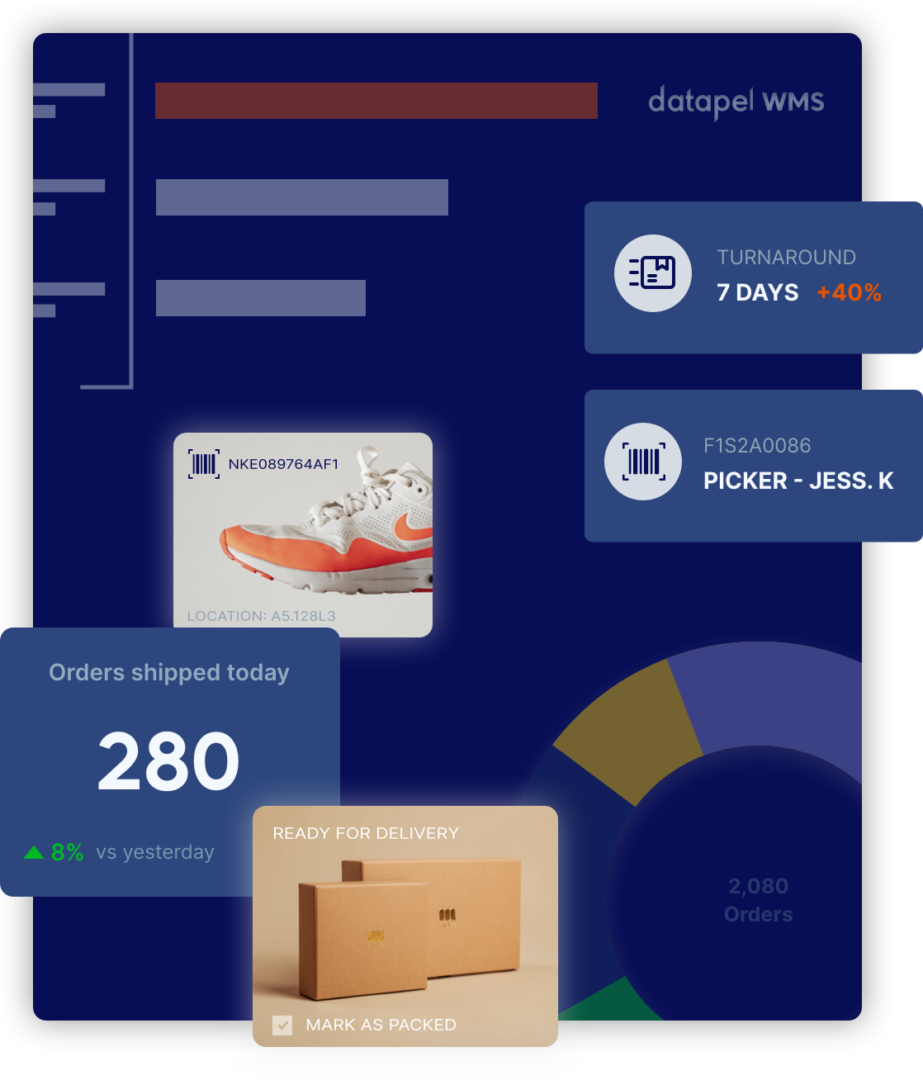How API Integration Can Supercharge Your Warehouse Efficiency
Contents
Imagine a warehouse where everything runs like clockwork.
Orders arrive, stock updates automatically, and shipments are processed without delays. No more juggling spreadsheets, no more manual data entry, and no more errors causing costly disruptions. Sounds ideal, doesn’t it?
That’s the kind of efficiency businesses strive for, and it’s exactly what Datapel’s Warehouse Management System (WMS) delivers through API integration. But how does it all come together? The answer lies in its Application Programming Interface (API)—the technology that connects your systems, automates workflows and ensures your operations run smoothly.
What Is an API integration and Why Does It Matter?
An API is essentially a digital connector that enables different software systems to “talk” to each other. Think of it as a conveyor belt in your warehouse, seamlessly transferring information between platforms. Instead of manually entering data from your eCommerce store into your WMS, an API does it instantly and without errors.
For businesses managing high order volumes, multiple sales channels, or complex supply chains, API integration is a game-changer. It ensures that stock levels, orders, and shipping details are always accurate and up to date, reducing manual tasks and improving efficiency.
How Datapel’s API Helps Your Business

Datapel’s API makes warehouse automation simple, helping you eliminate inefficiencies and streamline operations. Here’s how:
1. Automating Sales Order Imports
Picture this: A customer places an order on your online store. Within seconds, that order is automatically sent to your warehouse system, ready for picking and packing—no manual entry required. This is exactly what Datapel’s API does. It pulls sales orders directly into your WMS, ensuring smooth order processing and faster fulfilment.
2. Keeping Inventory in Sync
Managing stock manually can lead to overselling, backorders, and frustrated customers. Datapel’s API connects your sales channels, warehouses, and suppliers, ensuring stock levels update in real-time. Whether you sell online, in-store, or via wholesale, your inventory stays accurate, so you never sell what you don’t have.
3. Automating Customer and Supplier Data
Keeping track of customer and supplier information manually is time-consuming and prone to errors. The API integration ensures that all records are automatically updated, so your system always has the latest details—no need to worry about outdated contacts or incorrect addresses.
4. Streamlining Shipping and Fulfilment
Shipping delays and errors can damage customer satisfaction. Datapel’s API integrates directly with shipping carriers, generating tracking details and consignment notes instantly. Your customers get real-time shipping updates, and your team processes orders faster, leading to happier customers and more repeat business.
How Hampers With Bite Transformed Their Business with Datapel’s API integration
To see the impact of API automation in action, let’s take a look at Hampers With Bite, a leading Australian retailer of luxury gift hampers. As their business grew, their manual processes couldn’t keep up. Their outdated warehouse system slowed down order processing, leading to inefficiencies and potential order delays—especially during the busy Christmas season.
Their Challenges:
- Their old WMS couldn’t integrate with their ERP system, causing delays and duplication of work.
- They relied on manual data entry for bulk corporate orders, which was slow and error-prone.
- Shipping inefficiencies made it difficult to process high-order volumes quickly.
The API-Powered Solution:
By implementing Datapel Cloud.WMS and using API automation, Hampers With Bite achieved:
✅ Seamless System Integration – Orders, stock levels, and customer records automatically synced between Datapel and their ERP system.
✅ Faster Order Processing – A new batch order import system cut manual data entry time in half, reducing errors and improving efficiency.
✅ Improved Shipping & Tracking – Real-time freight management integration meant labels and tracking details were generated instantly, allowing faster dispatch.
The Result?
Hampers With Bite was able to process more orders, reduce admin work, and scale efficiently—all thanks to API automation. Their success highlights how a connected warehouse system can transform operations and improve business performance.
Getting Started with Datapel’s API integration

Ready to streamline your warehouse operations? Here’s how to get started with Datapel’s API:
- Explore API Documentation – Get familiar with the API’s capabilities and how it connects with your existing systems.
- Obtain API Credentials – Secure your unique API key to enable safe integration.
- Test in a Sandbox – Run trial integrations in Datapel’s testing environment to ensure everything works smoothly before going live.
- Deploy & Monitor – Once integrated, regularly review transactions to keep everything running at peak efficiency.
Best Practices for a Seamless Integration
To maximise the benefits of API automation, keep these best practices in mind:
- Ensure Data Consistency – Keep product SKUs, customer details, and tax codes aligned across all platforms.
- Focus on Security – Use secure authentication and limit API access to trusted sources.
- Optimise API Calls – Batch requests when possible to reduce system load and improve performance.
- Monitor Performance – Set up error tracking to identify and resolve any issues quickly.
Overcoming Common API Integration Challenges
Even the best integrations face challenges. Here’s how to overcome them:
- Data Discrepancies? Ensure that your sales channels, suppliers, and warehouse system are all using the same codes and identifiers.
- Rate Limits Slowing You Down? Optimise how often your system pulls updates to avoid hitting API request limits.
- Security Concerns? Implement best-in-class security standards to protect sensitive business data.
The Bottom Line
Datapel’s API integration isn’t just about automation—it’s about unlocking time, reducing errors, and making better business decisions. Whether you manage eCommerce sales, warehouse stock, or shipping logistics, the API ensures your operations run faster, smoother, and with less effort.
Ready to take your warehouse to the next level? Explore the Datapel API today and see how automation can transform your operations.
Need help? Our team is here to support you—book a call!
Datapel: Helping businesses lower costs, work smarter, and improve inventory management.

As a WMS Industry Analyst & Content Lead I write about warehouse management systems from real experience—helping businesses streamline operations, reduce errors, and scale smarter.
Over the past 8 years, I’ve worked closely with warehouse teams, tech developers, and business owners to break down complex supply chain problems into actionable solutions. My goal? Make WMS content useful, not just informative.
When I’m not writing, I’m digging into user feedback, testing new tools, or speaking with industry experts to stay ahead of what matters most to warehouse operators.







